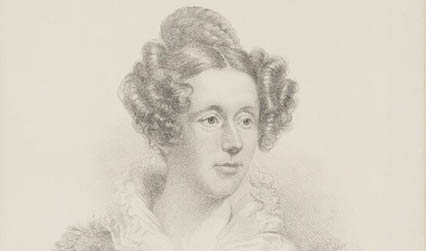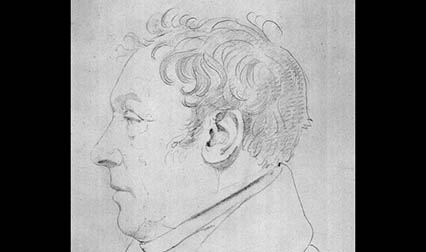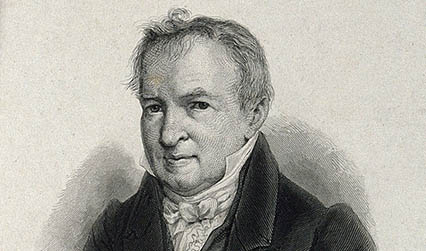As part of our season of women's history on the blog, Sarah Gillam looks at the life of the 19th century scientist Mary Somerville, and the assistance given to her by her husband, physician William Somerville.
In 1842, a bust of Mary Somerville (1780–1872), the mathematician and acclaimed science writer, was placed in the Grand Hall of the Royal Society, the leading scientific institution in London. The money for the bust, by the society sculptor Sir Francis Chantrey, had been raised from a subscription among the fellows, including the former president, Prince Augustus Frederick, the Duke of Sussex. Despite this unprecedented honour, as a woman Mary was barred from the fellowship of the Royal Society: to see the bust her husband, the Army doctor William Somerville (1771–1860), elected as a fellow in 1817, would have had to visit the Society on her behalf. That role would have felt familiar: as Mary’s adviser, confidant and helpmate in so many things, William played a significant part in supporting and encouraging his wife so she could study and write.

By 1842 Mary Somerville had published two highly successful science books. The first, Mechanism of the heavens (1831), began as an English translation of the French mathematician Pierre-Simon Laplace’s Mécanique céleste, but she expanded the work. Her ‘preliminary dissertation’ included an outline of the basic mathematics needed to understand Laplace’s ideas, a history of the subject and an explanation with her own drawings, diagrams and proofs. Her second book, On the connexion of the physical sciences (1834), was a compendium of the physical sciences, outlining for a popular audience the latest scientific knowledge. The book was an outstanding success, was translated into French, German and Italian, and went through ten editions over the next 40 years.
Brought up in Bruntisland, Fife, the daughter of a vice-admiral in the Navy, Mary had little formal education, but, with a fierce tenacity and against her parents’ wishes, managed to learn some algebra, geometry, Latin and Greek. It was only in 1807, after the death of her first husband (and cousin) Samuel Greig and the gaining of an inheritance and some independence, that she could begin her studies proper. Encouraged by John Playfair, professor of natural philosophy at the University of Edinburgh, she began to study mathematics as well as astronomy, chemistry, geography, microscopy, electricity and magnetism.

But it was only after her second marriage in 1812 to another cousin, William Somerville, that she began to meet and correspond with other scientific thinkers, exchange ideas and – with the encouragement and support of her husband – begin to write.
Like Mary, William had been brought up in Scotland, but this son of a Presbyterian minister and historian, described in Mary’s autobiography as ‘…generally well-informed, and very intelligent’, had had the advantage of a broad education and had travelled widely. He initially trained as a surgeon and entered the Army as a hospital assistant in March 1795. In the same year, he accompanied Sir James Henry Craig’s expedition to the Cape of Good Hope and was appointed as the garrison surgeon of Cape Town. During his years in Southern Africa, he was sent on several missions to negotiate with the Xhosa people, and from 1801 to 1802 journeyed 700 miles to the homeland of the Batlapin, an area then rarely visited by Europeans. On a sojourn back in Scotland, he graduated from Aberdeen University as a doctor of medicine. In 1805 he again accompanied Craig, this time to the Mediterranean, as part of the campaigns against Napoleon. He later travelled with Craig to Canada as inspector-general of hospitals and comptroller of customs in Quebec. On his return to the UK, at the age of 41, he married his younger cousin, Mary, and, in 1813, became head of the Army medical department in Scotland. Three years later, he was appointed as one of the principal inspectors of the Army medical board in England, and the Somervilles moved to London.
In the capital, William and Mary quickly became part of a large circle of thinkers, writers and artists, where the latest ideas and scientific discoveries were frequently discussed and debated. In 1817 William became a licentiate of the Royal College of Physicians and was elected to the fellowship of the Royal Society in the same year. Mary used many of the connections and contacts her husband made at these institutions: she regularly wrote with enthusiasm to other members, asking for updates on their investigations. They became family friends. In her autobiography we get glimpses of these encounters: the chemist William Hyde Wollaston gave her minerals to add to her collection; Thomas Young explained his method of dating Egyptian papyri astronomically; Sir William Edward Parry brought her seeds and minerals from the Arctic. She also became a regular visitor to the Herschel’s observatory in Slough. In 1817, the Somervilles toured the continent and Mary met many leading French and German scientific thinkers, including the geographer, naturalist and explorer Alexander von Humboldt. These friendships and contacts meant she was in a perfect position to write On the connexions…, a compendium of the latest scientific discoveries of the day.

Following the then etiquette, William also acted as an informal intermediary between Mary and her publishers. In March 1827 Lord Henry Brougham, the High Chancellor, wrote to William, asking if Mary would take on the great task of translating Laplace’s huge work, to be published by his Society for the Diffusion of Useful Knowledge. William also gave his wife invaluable practical assistance, as her copyist, proof-reader and researcher. As their daughter, Martha, noted in her mother’s autobiography: ‘He was far happier in helping my mother in various ways, searching the libraries for the books she required, indefatigably copying and recopying her manuscripts to save her time. No trouble seemed too great which he bestowed upon her; it was a labour of love.’
The emotional support William gave to his wife was probably his most important contribution to her work. Mary seems to have been ambivalent about her abilities and her public role as a pioneering female science writer. While she was the first to sign John Stuart Mill’s unsuccessful 1868 petition to give women the right to vote, she sometimes played down her (and her gender’s) intellect. In a draft of her autobiography she wrote: ‘I was conscious that I never made a discovery myself, that I had no originality. I have perseverance and intelligence but no genius, that spark from heaven is not granted to the sex, we are of the earth…’

In 1848, Mary was preparing to publish her book Physical geography, which had the expansive remit of describing ‘…the earth, the sea and the air, with their inhabitants, animal and vegetable, of the distribution of these organized beings, and the causes of that distribution’, but learnt Humboldt had just published Kosmos, a similar work in German. It was William who persuaded her not to put her manuscript on the fire and to at least send the work to their friend Sir John Herschel for his advice. Physical geography went on to become her most successful work.
While Mary should be recognised for her genius as a mathematician and an expositor of 19th century science, William should be remembered as her principal supporter and encourager, a man of exceptional kindness, gifted with an ability to set aside his own ambitions. Mary acknowledged his contribution in the autobiography she wrote towards the end of her life: ‘The warmth with which Somerville entered into my success deeply affected me; for not one in ten thousand would have rejoiced at it as he did; but he was of a generous nature, far above jealousy, and he continued through life to take the kindest interest in all I did.’
Sarah Gillam, assistant editor of Munk’s Roll
The exhibition This vexed question: 500 years of women in medicine opened on 19 September 2018 and runs until 18 January 2019.
The following sources were used when writing this post:
- Alic M. Hypatia’s heritage: a history of women in science from antiquity to the late nineteenth century. London: The Women’s Press Ltd, 1986.
- Baraniuk C. The queen of science. New Scientist 1 July 2017 (3132):40-41.
- Clerke EM. Somerville, William (1771-1860). Oxford Dictionary of National Biography www.oxforddnb.com/view/10.1093/ref:odnb/9780198614128.001.0001/odnb-9780198614128-e-26027?rskey=gVJduZ&result=4 [accessed 9 November 2018].
- Crease MRS. Somerville [née Fairfax; other married name Greig], Mary (1780-1872). Oxford Dictionary of National Biography www.oxforddnb.com/view/10.1093/ref:odnb/9780198614128.001.0001/odnb-9780198614128-e-26024?rskey=Cbz0wF&result=5 [accessed 9 November 2018].
- Secord J. Mary Somerville and the empire of nineteenth century science. London: The Royal Society, 2014. www.youtube.com/watch?v=KBTeXabfqtw&t=2097s [accessed 9 November 2018].
- Somerville M. Personal recollections from early life to old age of Mary Somerville with selections from her correspondence. London: John Murray, 1874.
